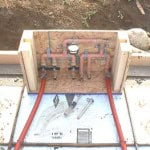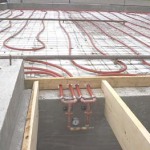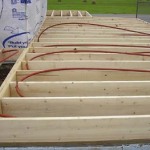Two unconventional variations of a standard radiant installation.
- The conventional slab manifold. Normally, the first circuit of tubing starts at the far left connection and ends at the far right. This makes it easy for the remaining circuits to fall within the first one. With this approach, no crossing of tubing is necessary. Also, note the valves on the supply side of the manifold. These are not for the purpose of regulating flow through the circuits, but instead are there as a convenience to help the installer fill the radiant system. With valves at the beginning of each circuit, the system can be filled with water and purged of air one circuit at a time.
- The unconventional manifold. Every installation is unique and it’s important to maintain an attitude of flexibility when designing a radiant system. In this application, the slab manifold is upside down, but perfectly suited to its situation.
- Notching the joists. Feeding the 7/8″ PEX through holes drilled in the joists is the normal method of installation, but if the situation warrants, notching can also be used. If the subfloor has yet to be installed, and the notch is round at the bottom to eliminate a “shear point”, this method can save a lot of time and effort without compromising the integrity of the joists.



